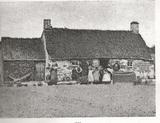Famous People
William Small (1734-1775)
Rev James Small was minister of Carmyllie from 1719 to 1771. He was married in 1722 and had five children of which four survived, Anne, unmarried, James became a Dundee merchant, Robert was ordained as a minister in Dundee.
The fifth child, William became a physician and travelled to America where he taught at William & Mary College, Virginia, his most famous pupil being Thomas Jefferson. He returned as a physician to Birmingham.
James Bowman Lindsay (1799-1862)
 James Bowman Lindsay was born in Carmyllie and
in his childhood he was occupied as a weaver yet
had a keen interest in books. Later he trained as a
minister at St Andrews and in his vacation set up a
school for local children at Dilty Moss.
James Bowman Lindsay was born in Carmyllie and
in his childhood he was occupied as a weaver yet
had a keen interest in books. Later he trained as a
minister at St Andrews and in his vacation set up a
school for local children at Dilty Moss.
He never followed the ministry as a career instead he moved into Dundee where he was able to follow his keen interest in science. He experimented and was successful in the invention of the electric bulb and also with wireless telegraphy through water. He was also able to divert his interests to compose a dictionary in fifty different languages.
Rev Patrick Bell (1801-1869)
 Rev Patrick Bell is most noted for his invention of the reaping machine. When
at his father's farm at Auchterhouse he
experimented with the machine as well as
training for the ministry at St Andrews.
Rev Patrick Bell is most noted for his invention of the reaping machine. When
at his father's farm at Auchterhouse he
experimented with the machine as well as
training for the ministry at St Andrews.
After the invention was proved a success he obtained teaching posts in America before returning to be ordained as a minister at Carmyllie Parish Church in 1843. He continued with other small inventions in the top room of the manse. He died in harness and was buried in Carmyllie churchyard.
William Fyffe (1847-1917)
William Fyffe was born in Letham, Angus and brought up by his grandparents. In 1854 his grandparents were given the tenancy of the Birns, rent free, in exchange for 'breaking in' the land.
He attended Monikie school in winter and herded 'kye' in summer. At 16 he was accepted as office clerk at McGourlay's shipyard in Dundee, soon realising that foreigners arrived wishing to do business in their language. William learnt first French then Spanish and was called upon for interpretation.
He taught evening classes to young men and the three Rs to the shipyard workers. Later he taught languages at Morgan Academy and privately. In 1880 he published a book entitled 'Holiday Sketches and Work-a-day Essays'.
